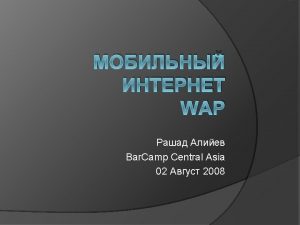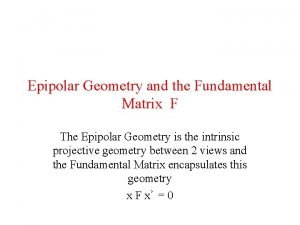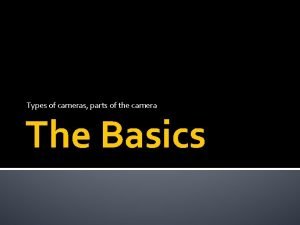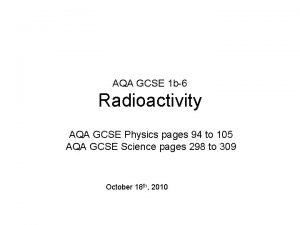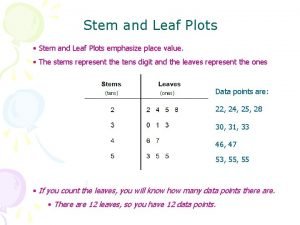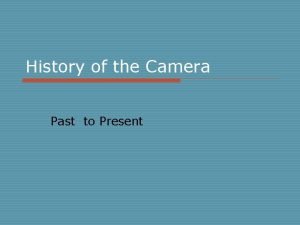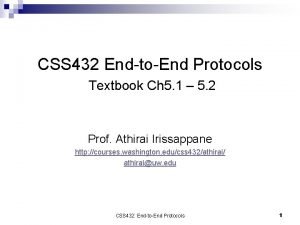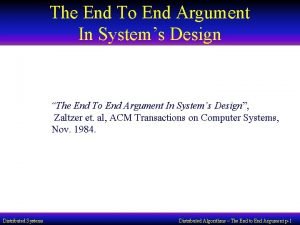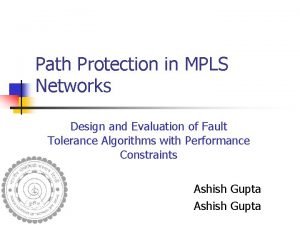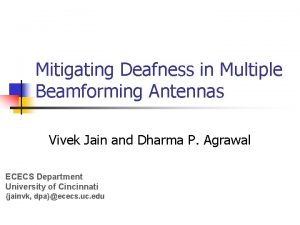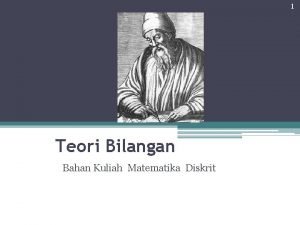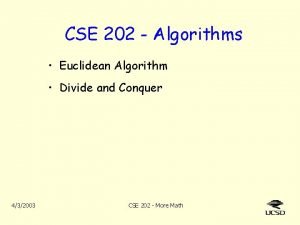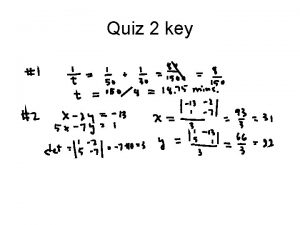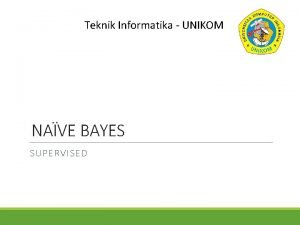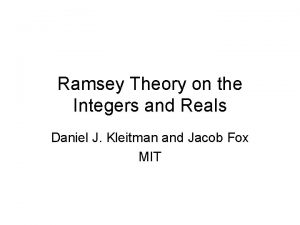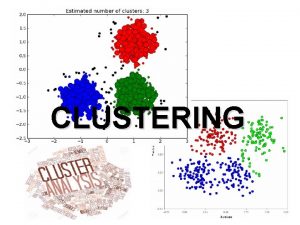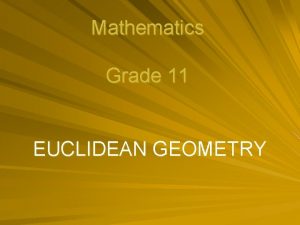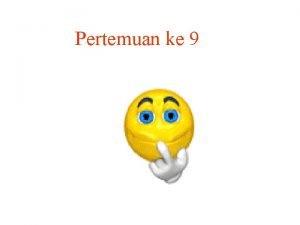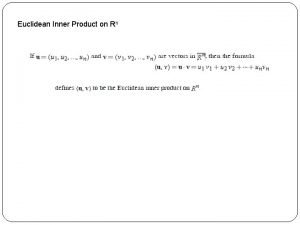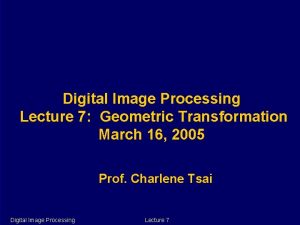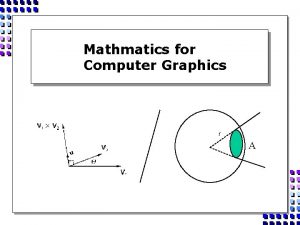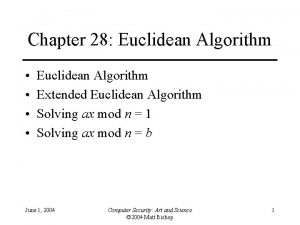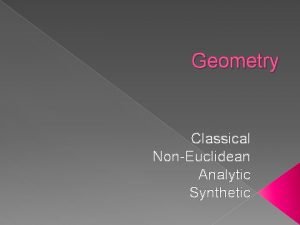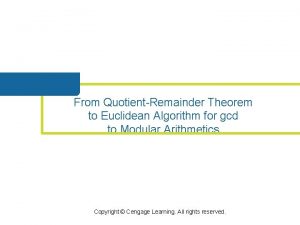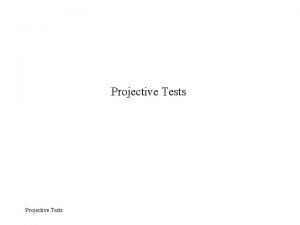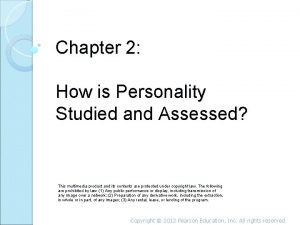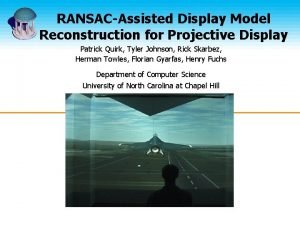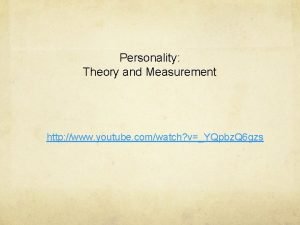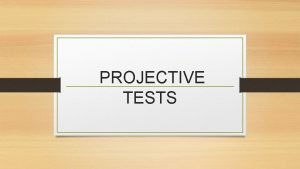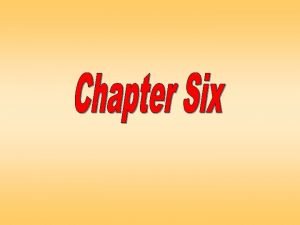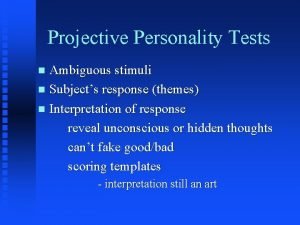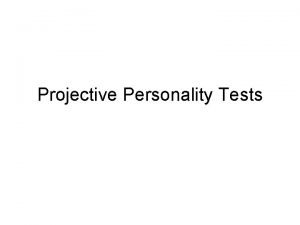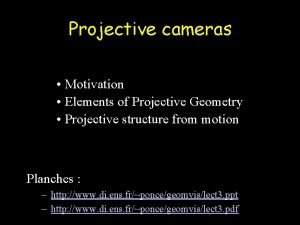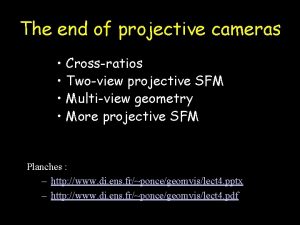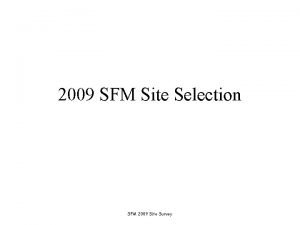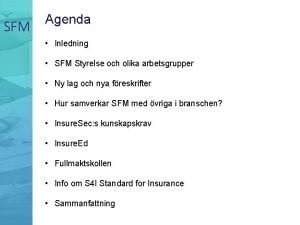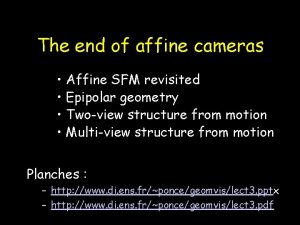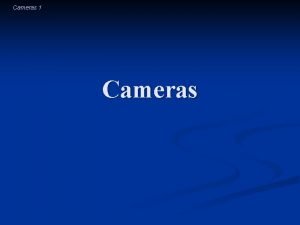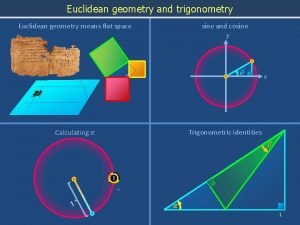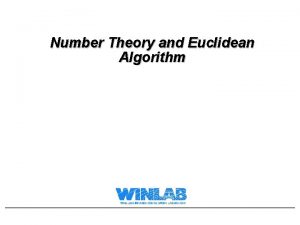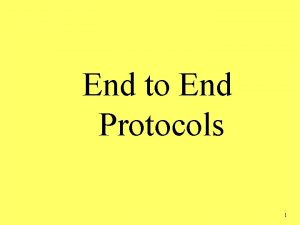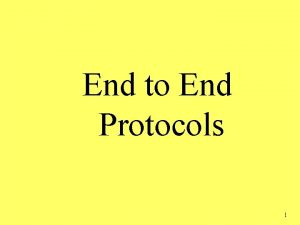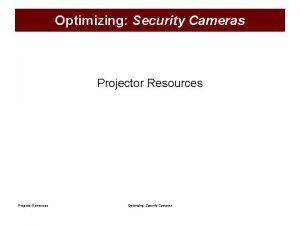Projective cameras The end of projective SFM Euclidean





![A different view of the fundamental matrix • Projective ambiguity ! M’Q=[Id 0] MQ=[A A different view of the fundamental matrix • Projective ambiguity ! M’Q=[Id 0] MQ=[A](https://slidetodoc.com/presentation_image_h2/31c748f65d801fb6cb0ccd94dd96a586/image-6.jpg)






































![Coordinate changes --- Metric upgrades x’ ¼ P ( H H-1 ) x H=[Xy] Coordinate changes --- Metric upgrades x’ ¼ P ( H H-1 ) x H=[Xy]](https://slidetodoc.com/presentation_image_h2/31c748f65d801fb6cb0ccd94dd96a586/image-45.jpg)


















![Plücker coordinates and the Klein quadric x Note: y [] P 5 u =xÇy= Plücker coordinates and the Klein quadric x Note: y [] P 5 u =xÇy=](https://slidetodoc.com/presentation_image_h2/31c748f65d801fb6cb0ccd94dd96a586/image-64.jpg)













- Slides: 77

Projective cameras • The end of projective SFM • Euclidean upgrades • Line geometry • Purely projective cameras Présentations mercredi 26 mai de 9 h 30 à midi, salle U/V Planches : – http: //www. di. ens. fr/~ponce/geomvis/lect 5. ppt – http: //www. di. ens. fr/~ponce/geomvis/lect 5. pdf

An Affine Trick. . Algebraic Scene Reconstruction Method

From Affine to Vectorial Structure Idea: pick one of the points (or their center of mass) as the origin.

What if we could factorize D? (Tomasi and Kanade, 1992) Affine SFM is solved! Singular Value Decomposition We can take

Back to perspective: Euclidean motion from E (Longuet-Higgins, 1981) • Given F computed from n > 7 point correspondences, and its SVD F= UWVT, compute E=U diag(1, 1, 0) VT. • There are two solutions t’ = u 3 and t’’ = -t’ to ETt=0. • Define R’ = UWVT and R” = UWTVT where (It is easy to check R’ and R” are rotations. ) • Then [t£’]R’ = -E and [t£’]R” = E. Similar reasoning for t”. • Four solutions. Only two of them place the reconstructed points in front of the cameras.
![A different view of the fundamental matrix Projective ambiguity MQId 0 MQA A different view of the fundamental matrix • Projective ambiguity ! M’Q=[Id 0] MQ=[A](https://slidetodoc.com/presentation_image_h2/31c748f65d801fb6cb0ccd94dd96a586/image-6.jpg)
A different view of the fundamental matrix • Projective ambiguity ! M’Q=[Id 0] MQ=[A b]. • Hence: zp = [A b] P and z’p’ = [Id 0] P, with P=(x, y, z, 1)T. • This can be rewritten as: zp = ( A [Id 0] + [0 b] ) P = z’Ap’ + b. • Or: z (b £ p) = z’ (b £ Ap’). • Finally: p. TFp’ = 0 with F = [b£] A.

Projective motion from the fundamental matrix • Given F computed from n > 7 point correspondences, compute b as the solution of FTb=0 with |b|2=1. • Note that: [a£]2 = aa. T - |a|2 Id for any a. • Thus, if A 0 = - [b£] F, [b£] A 0 = - [b£]2 F = - bb. TF + |b|2 F = F. • The general solution is M = [A b] with A = A 0 + ( b | b).

Two-view projective reconstruction. Mean relative error: 3. 0%

Bundle adjustment Use nonlinear least-squares to minimize:

Bundle adjustment. Mean relative error: 0. 2%

Projective SFM from multiple images z 11 p 11 … z 1 np 1 n M 1 … … … = … P_1 … P_n zm 1 pm 1 … zmnpmn Mm , D = MP • If the zij’s are known, can be done via SVD. In principle the zij’s can be found pairwise from F (Triggs 96). • Alternative, eliminate zij from the minimization of E=|D-MP| • This reduces the problem to the minimization of E = ij |pij £ Mi. Pj|2 under the constraints |Mi|2=|Pj|2=1 with |pij|2=1. • Bilinear problem. 2

Bilinear projective reconstruction. Mean relative error: 0. 2%

From uncalibrated to calibrated cameras Weak-perspective camera: Calibrated camera: Problem: what is Q ? Note: Absolute scale cannot be recovered. The Euclidean shape (defined up to an arbitrary similitude) is recovered.

Reconstruction Results (Tomasi and Kanade, 1992) Reprinted from “Factoring Image Sequences into Shape and Motion, ” by C. Tomasi and T. Kanade, Proc. IEEE Workshop on Visual Motion (1991). 1991 IEEE.

What is some parameters are known? Weak-perspective camera: Zero skew: 0 Problem: what is Q ? Self calibration!

v 0 f l k Kruppa (1913); Maybank & Faugeras (1992) u 0 П 1 , , u 0, v 0 x’ ¼ P ( H H-1 ) x H=[Xy] Triggs (1997); Pollefeys et al. (1998, 2002) Chasles’ absolute conic: x 12+x 22+x 32 = 0, x 4 = 0. The absolute quadric u 0 = v 0 = 0 2 = 2, = 0 The absolute quadratic complex

Relation between K, , and *

x ξ c y c r Purely projective cameras

x x ξ c y c r ξ

The join of two points and Plücker coordinates (Euclidean version for) v Note: u. v=0 y u x O y–x u = x Ç y = x £ y = v = (u ; v) s

The join of two points and Plücker coordinates (projective version) v Note: u. v=0 y u x O [] u =xÇy= v

An inner product for lines ( | ) = 0 Note: ( | )= 2 u. v = 0 = (u ; v) ! * = (v ; u) = (s ; t) ! ( | ) = *. = . * = u. t + v. s

Interpreting Plűcker coordinates P 5 the Klein quadric line screw

Duality p 2 p 1 x p 3 x. pk = 0 x* = { p | x. p = 0 }

The meet of two planes q p = p Æ q = ( p Ç q )*

Line duality y y* x * = x* Æ y* = ( x Ç y )* x* *

The joint of a line and a point p= Çx When if Ç x equal to 0? x p = [ Ç] x where [ Ç] = [u£] v -v. T 0

The meet of a line and a plane x= Æp p x = [ Æ] p where [ Æ] = [ *Ç] When if Æ p equal to 0?

1 2 3 4 5 6 Coplanar lines and Line bundles

Line bundles x 2 c x 1 x 3 » = u 1 » 1 + u 2 » 2 + u 3 » 3 x x

Line bundles x 2 r y 2 c y 1 x 1 y 3 y x 3 » = u 1 » 1 + u 2 » 2 + u 3 » 3 y = u 1 y 1 + u 2 y 2 + u 3 y 3 x x

Line bundles x 2 r y 2 c y 1 x 1 y 3 y x 3 » = X u , where X 2 R 6£ 3, u 2 R 3 y = Y u , where Y 2 R 4£ 3, u 2 R 3 x x

Line bundles x 2 r y 2 c y 1 x 1 y 3 Note: y x 3 u = Y z y y = Y z y [(c Ç x) Æ r] x x

Line bundles x 2 r y 2 c y 1 x 1 y 3 y Note: (c Ç x) Æ r = [c x. T – x c. T ] r x 3 u = Y z y y = Y z y [(c Ç x) Æ r] x x

Line bundles x 2 r y 2 c y 1 x 1 y 3 y x 3 u = Y z y y = Y z y [(c Ç x) Æ r] = P x when z = c x x

r z c u¼Px m ¼ P* l p’ m p¼PTm ¼PT y y l Perspective projection x

Epipolar Geometry • Epipolar Plane • Epipoles • Epipolar Lines • Baseline

The fundamental matrix revisited x 1 y 1 T y ¼ P 1 1 x 1 T y ¼ P 2 2 x 2 y 2 (» 1 | » 2) = 0 y 1 T F y 2 = 0

Trinocular Epipolar Constraints

1 2 3 4 5 6 The trifocal tensor revisited T ( y 1 , y 2 , y 3 ) = 0

The trifocal tensor revisited 1 2 3 4 5 6 x δ η φ 1 2 3 4 5 6 (Ponce et al. , CVPR’ 05) Di (» 1 , » 2 , » 3 ) = 0 or T i (u 1 , u 2 , u 3 ) = 0, for i = 1, 2, 3, 4

r z c y¼Px m ¼ P* l p’ m p¼PTm ¼PT y y l Perspective projection x

Dual perspective projection c r ’ p’ p’ ¼ X T p ’ ¼ X * x’ ¼ X ¼X p x’ T T ’ p’ x’ ¼ X*

П 1 Chasles’ absolute conic: x 12 + x 22 + x 32 = 0, x 4 = 0. The absolute quadratic complex: T diag(Id, 0) = | u |2 = 0.
![Coordinate changes Metric upgrades x ¼ P H H1 x HXy Coordinate changes --- Metric upgrades x’ ¼ P ( H H-1 ) x H=[Xy]](https://slidetodoc.com/presentation_image_h2/31c748f65d801fb6cb0ccd94dd96a586/image-45.jpg)
Coordinate changes --- Metric upgrades x’ ¼ P ( H H-1 ) x H=[Xy] Planes: ep. T Points: ex Lines: e = H pp. T = H-1 px = p

Perspective projection Proposition : P PT¼ r Proposition : P * P T ¼ * y’ c Triggs (1997); Pollefeys et al. (1998) x’ ¼ P x ’ ¼ P* p’ ’ p’ ¼ P T ’ ¼ P T x’ x’ x The AQC general equation: T = 0, with = X*TX* Proposition: T ’ ¼ û¢ û’ ep. T ex e = H pp. T = H-1 px = p

Relation between K, , and *

Non-linear, 7 images Non-linear, 196 images Non-linear, 20 images Linear, 20 images 2480 points tracked in 196 images

Canon XL 1 digital camcorder, 480£ 720 pixel 2 (Ponce & Mc. Henry, 2004) Projective structure from motion : Mahamud, Hebert, Omori & Ponce (2001)

Quantitative comparaison with Pollefeys et al. (1998, 2002) (synthetic cube with 30 cm edges, corrupted by Gaussian noise)

What is a camera? x (Ponce, CVPR’ 09) ξ c y r x

x ξ c y c r

x x ξ c y c r ξ

x ξ c y c r ξ

x ξ c y c r ξ x ξ y r Linear family of lines ξ

Lines linearly dependent on 2 or 3 lines (Veblen & Young, 1910) © H. Havlicek, VUT Then go on recursively for general linear dependence

What a camera is Definition: A camera is a two-parameter linear family of lines – that is, a degenerate regulus, or a non-degenerate linear congruence.

Rank-3 families: Reguli Line fields ≡ epipolar plane images (Bolles, Baker, Marimont, 1987) Line bundles

Rank-4 (nondegenerate) families: Linear congruences Figures © H. Havlicek, VUT

Hyperbolic linear congruences x ξ r y Crossed-slit cameras (Zomet et al. , 2003) ξ x Linear pushbroom cameras (Gupta & Hartley, 1997)

© Leica © E. Molzcan Hyperbolic linear congruences

Elliptic linear congruences Linear oblique cameras (Pajdla, 2002) Bilinear cameras (Yu & Mc. Millan, 2004) Stereo panoramas / cyclographs (Seitz & Kim, 2002) © T. Pajdla, CTU

Parabolic linear congruences Pencil cameras (Yu & Mc. Millam, 2004) Axial cameras (Sturm, 2005)
![Plücker coordinates and the Klein quadric x Note y P 5 u xÇy Plücker coordinates and the Klein quadric x Note: y [] P 5 u =xÇy=](https://slidetodoc.com/presentation_image_h2/31c748f65d801fb6cb0ccd94dd96a586/image-64.jpg)
Plücker coordinates and the Klein quadric x Note: y [] P 5 u =xÇy= v u. v=0 the Klein quadric line screw

Pencils of screws and linear congruences Reciprocal screws: (s | t) = 0 P 5 the Klein quadric Screw ≈ linear complex: s≈{± | (s|±)=0} line s

Pencils of screws and linear congruences Reciprocal screws: (s | t) = 0 P 5 the Klein quadric Screw ≈ linear complex: s≈{± | (s|±)=0} Pencil of screws: l = { s + t ; , 2 R } The carrier of l is a linear congruence l s t line

Pencils of screws and linear congruences Reciprocal screws: (s | t) = 0 P 5 Screw ≈ linear complex: s≈{± | (s|±)=0} h p Pencil of screws: l = { s + t ; , 2 R } The carrier of l is a linear congruence e

Hyperbolic linear congruences x ± 2 »

Hyperbolic linear congruences » 1 » 2 x » 3 p 1 » 4 ± 2 ± 1 p 2 » » = (x. T[ p 1 p 2 T]x) » 1 + (x. T[ p 1 p 2 T]x) » 2 + (x. T[ p 1 p 2 T]x) » 3 + (x. T[ p 1 p 2 T]x) » 4

Hyperbolic linear congruences » 1 » 2 » x » 3 p 1 » 4 ± 2 ± 1 p 2 y » = (y. T[ p 1 p 2 T] y) » 1 + (y. T[ p 1 q 2 T] y) » 2 + (y. T[ q 1 p 2 T] y) » 3 + (y. T[ q 1 q 2 T] y) » 4 y = u 1 y 1 + u 2 y 2 + u 3 y 3 = Y u

Hyperbolic linear congruences » 1 » 2 » x » 3 p 1 » 4 ± 2 ± 1 p 2 y » = (u. T[ ¼ 1¼ 2 T]u) » 1 + (u. T[ ¼ 1 2 T]u) » 2 + (u. T[ 1¼ 2 T]u) » 3 + (u. T[ 1 2 T]u) » 4 = X û , where X 2 R 6£ 4 and û 2 R 4

Parabolic linear congruences a 2 p z p 1 a 1 x ξ ± » = X û , where X 2 R 6£ 5 and û 2 R 5 ° s ± T

Elliptic linear congruences x » y » = X û , where X 2 R 6£ 4 and û 2 R 4

Epipolar geometry Feldman et al. (2003): 6£ 6 F for crossed-slit cameras Gupta & Hartley (1997): 4£ 4 F for linear pushbroom cameras x » 1 » 2 y 1 (» 1 | » 2 ) = 0 or û F û 2 = 0, where F = X 1 X 2 2 R 4£ 4 T 1 T

Trinocular geometry 1 2 3 4 5 6 x δ η 1 2 3 4 5 6 φ Di (» 1 , » 2 , » 3 ) = 0 or Ti (û 1 , û 2 , û 3 ) = 0, for i = 1, 2, 3, 4

The essential map (Oblique cameras, Pajdla, 2002) Canonical forms of essential maps A ( = matrices with quadratic minimal poylnomial) x B Ax H P ξ x ! ξ = x Ç Ax E (Batog, Goaoc, Ponce, 2009) Alternative geometric characterization of linear congruences

A new elliptic camera? (Batog, Goaoc, Ponce, 2010)
 Wapforum
Wapforum Speed detection of moving vehicle
Speed detection of moving vehicle Canonical cameras
Canonical cameras Parts of cameras
Parts of cameras Gamma cameras bbc bitesize
Gamma cameras bbc bitesize What is a stem and leaf diagram
What is a stem and leaf diagram Camera past tense
Camera past tense Jacobs cameras
Jacobs cameras Ejection fraction vs stroke volume
Ejection fraction vs stroke volume Yichao zhou
Yichao zhou End to end
End to end Compiler front end and back end
Compiler front end and back end End to end accounting life cycle tasks
End to end accounting life cycle tasks End to end argument
End to end argument End-to-end construction of nlp knowledge graph
End-to-end construction of nlp knowledge graph Back end
Back end End to end delay
End to end delay Stroke volume
Stroke volume End-to-end procurement life cycle
End-to-end procurement life cycle Kolondivertikulose definition
Kolondivertikulose definition End to end delay
End to end delay Euclidean space
Euclidean space Contoh soal kombinasi lanjar
Contoh soal kombinasi lanjar Cse 202
Cse 202 Euclidean algorithm example
Euclidean algorithm example Jarak euclidean
Jarak euclidean Bitonic euclidean traveling salesman problem
Bitonic euclidean traveling salesman problem Euclidean space
Euclidean space Euclidean ramsey theory
Euclidean ramsey theory Contoh soal euclidean distance
Contoh soal euclidean distance Tan-chord theorem
Tan-chord theorem Pernyataan 4 x (9-4) = 36 -16 memenuhi sifat….
Pernyataan 4 x (9-4) = 36 -16 memenuhi sifat…. What is euclidean inner product
What is euclidean inner product Non euclidean
Non euclidean Geometric transformation in digital image processing
Geometric transformation in digital image processing Rumus euclidean distance
Rumus euclidean distance Euclidean transformation
Euclidean transformation Extended euclidean algorithm
Extended euclidean algorithm Euclidean method gcf
Euclidean method gcf Geometry
Geometry Contoh soal euclidean distance
Contoh soal euclidean distance Euclidean algorithm
Euclidean algorithm Projective hypothesis
Projective hypothesis Pychology test
Pychology test Projective geometry
Projective geometry Bandura's reciprocal determinism
Bandura's reciprocal determinism Projective monitor
Projective monitor Projective listening
Projective listening Retrospective labeling definition
Retrospective labeling definition Projective techniques of data collection
Projective techniques of data collection Freudian slip meaning
Freudian slip meaning Youtube
Youtube Projective test psychology definition
Projective test psychology definition Pros and cons of focus groups
Pros and cons of focus groups Projective monitor
Projective monitor Projective techniques in exploratory research
Projective techniques in exploratory research Ambiguous stimuli test
Ambiguous stimuli test Greek personality test
Greek personality test Intuitive projective faith
Intuitive projective faith Rorschach test meanings
Rorschach test meanings Projective open ended story test
Projective open ended story test Psychodynamic perspective of schizophrenia
Psychodynamic perspective of schizophrenia Identification (defense mechanism)
Identification (defense mechanism) Features of projective personality test
Features of projective personality test Projective test advantages and disadvantages
Projective test advantages and disadvantages Publicité mécaniste
Publicité mécaniste Projective identification
Projective identification độ dài liên kết
độ dài liên kết Chó sói
Chó sói Khi nào hổ mẹ dạy hổ con săn mồi
Khi nào hổ mẹ dạy hổ con săn mồi Thiếu nhi thế giới liên hoan
Thiếu nhi thế giới liên hoan điện thế nghỉ
điện thế nghỉ Một số thể thơ truyền thống
Một số thể thơ truyền thống Trời xanh đây là của chúng ta thể thơ
Trời xanh đây là của chúng ta thể thơ Frameset trong html5
Frameset trong html5 Số nguyên tố là gì
Số nguyên tố là gì Phối cảnh
Phối cảnh đặc điểm cơ thể của người tối cổ
đặc điểm cơ thể của người tối cổ
